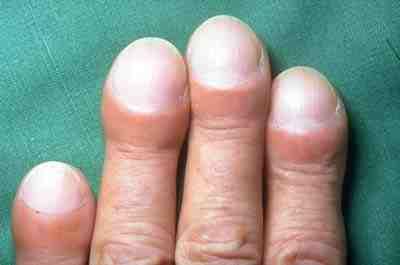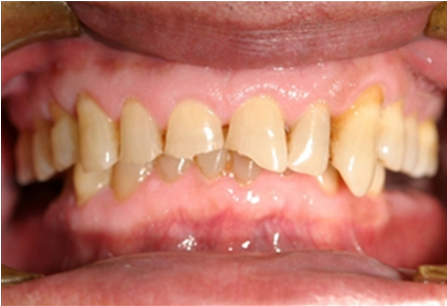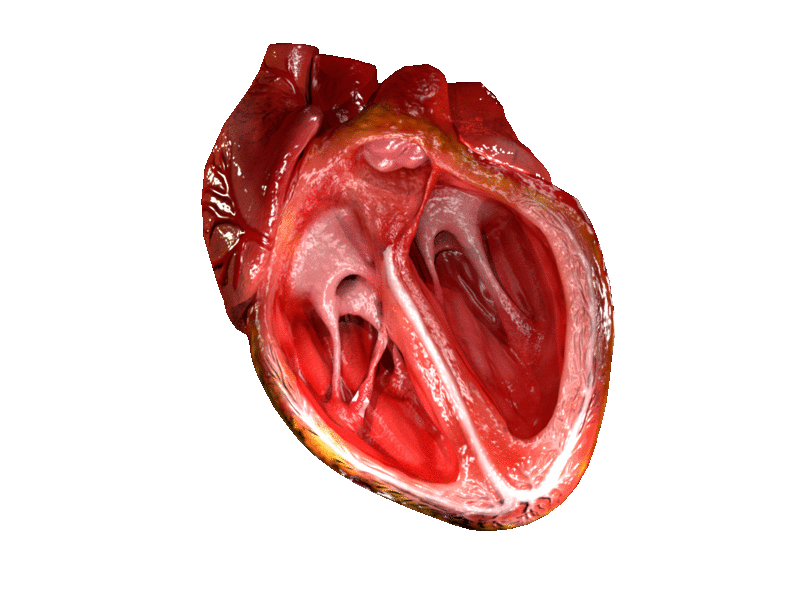|
Idiopathic Pulmonary Fibrosis
Idiopathic pulmonary fibrosis (IPF) synonymous with cryptogenic fibrosing alveolitis is a rare, progressive illness of the respiratory system, characterized by the thickening and stiffening of lung tissue, associated with the formation of scar tissue. It is a type of chronic pulmonary fibrosis characterized by a progressive and irreversible decline in lung function. The tissue in the lungs becomes thick and stiff, which affects the tissue that surrounds the air sacs in the lungs. Symptoms typically include gradual onset of dypsnea, shortness of breath and a dry cough. Other changes may include feeling tired, and nail clubbing, clubbing abnormally large and dome shaped finger and toenails. Complications may include pulmonary hypertension, heart failure, pneumonia or pulmonary embolism. The cause is unknown, hence the term Idiopathic disease, idiopathic. Risk factors include cigarette smoking, gastroesophageal reflux disease, certain viral infections, and genetic predisposition ... [...More Info...] [...Related Items...] OR: [Wikipedia] [Google] [Baidu] |
Pulmonology
Pulmonology (, , from Latin ''pulmō, -ōnis'' "lung" and the Greek suffix "study of"), pneumology (, built on Greek πνεύμων "lung") or pneumonology () is a medical specialty that deals with diseases involving the respiratory tract.ACP: Pulmonology: Internal Medicine Subspecialty . Acponline.org. Retrieved on 2011-09-30. It is also known as respirology, respiratory medicine, or chest medicine in some countries and areas. Pulmonology is considered a branch of internal medicine, and is related to intensive care medicine. Pulmonology often ... [...More Info...] [...Related Items...] OR: [Wikipedia] [Google] [Baidu] |
Nintedanib
Nintedanib, sold under the brand names Ofev and Vargatef, is an oral medication used for the treatment of idiopathic pulmonary fibrosis and along with other medications for some types of non-small-cell lung cancer. In March 2020, it was approved for use in the United States to treat chronic fibrosing (scarring) interstitial lung diseases (ILD) with a progressive phenotype (trait). It is the first treatment for this group of fibrosing lung diseases that worsen over time that was approved by the U.S. Food and Drug Administration (FDA). Common side effects include abdominal pain, vomiting, and diarrhea. It is a small molecule tyrosine-kinase inhibitor, targeting vascular endothelial growth factor receptor, fibroblast growth factor receptor and platelet derived growth factor receptor. Ofev was developed by Boehringer Ingelheim. It received U.S. Food and Drug Administration (FDA) approval for use for idiopathic pulmonary fibrosis in 2014 – one of only two drugs available fo ... [...More Info...] [...Related Items...] OR: [Wikipedia] [Google] [Baidu] |
Pulmonary Rehabilitation
Pulmonary rehabilitation, also known as respiratory rehabilitation, is an important part of the management and health maintenance of people with chronic respiratory disease who remain symptomatic or continue to have decreased function despite standard medical treatment. It is a broad therapeutic concept. It is defined by the American Thoracic Society and the European Respiratory Society as an evidence-based, multidisciplinary, and comprehensive intervention for patients with chronic respiratory diseases who are symptomatic and often have decreased daily life activities. In general, pulmonary rehabilitation refers to a series of services that are administered to patients of respiratory disease and their families, typically to attempt to improve the quality of life for the patient. Pulmonary rehabilitation may be carried out in a variety of settings, depending on the patient's needs, and may or may not include pharmacologic intervention. Medical uses The NICE clinical guideline ... [...More Info...] [...Related Items...] OR: [Wikipedia] [Google] [Baidu] |
Usual Interstitial Pneumonia
Usual interstitial pneumonia (UIP) is a form of lung disease characterized by progressive scarring of both lungs. The scarring ( pulmonary fibrosis) involves the pulmonary interstitium (the supporting framework of the lung). UIP is thus classified as a form of interstitial lung disease. Terminology The term "usual" refers to the fact that UIP is the most common form of interstitial fibrosis. "Pneumonia" indicates "lung abnormality", which includes fibrosis and inflammation. A term previously used for UIP in the British literature is cryptogenic fibrosing alveolitis (CFA), a term that has fallen out of favor since the basic underlying pathology is now thought to be fibrosis, not inflammation. The term usual interstitial pneumonitis (UIP) has also often been used, but again, the ''-itis'' part of that name may overemphasize inflammation. Signs and symptoms The typical symptoms of UIP are progressive shortness of breath and cough for a period of months. In some patients, UIP is dia ... [...More Info...] [...Related Items...] OR: [Wikipedia] [Google] [Baidu] |
High-resolution Computed Tomography
High-resolution computed tomography (HRCT) is a type of computed tomography (CT) with specific techniques to enhance image resolution. It is used in the diagnosis of various health problems, though most commonly for lung disease, by assessing the lung parenchyma. On the other hand, HRCT of the temporal bone is used to diagnose various middle ear diseases such as otitis media, cholesteatoma, and evaluations after ear operations. Technique HRCT is performed using a conventional CT scanner. However, imaging parameters are chosen so as to maximize spatial resolution: a narrow slice width is used (usually 1–2 mm), a high spatial resolution image reconstruction algorithm is used, field of view is minimized, so as to minimize the size of each pixel, and other scan factors (e.g. focal spot) may be optimized for resolution at the expense of scan speed. Depending on the suspected diagnosis, the scan may be performed in both inspiration and expiration. In inspiration images are ... [...More Info...] [...Related Items...] OR: [Wikipedia] [Google] [Baidu] |
Gastroesophageal Reflux Disease
Gastroesophageal reflux disease (GERD) or gastro-oesophageal reflux disease (GORD) is a chronic upper gastrointestinal disease in which stomach content persistently and regularly flows up into the esophagus, resulting in symptoms and/or complications. Symptoms include dental corrosion, dysphagia, heartburn, odynophagia, regurgitation, non-cardiac chest pain, extraesophageal symptoms such as chronic cough, hoarseness, reflux-induced laryngitis, or asthma. In the long term, and when not treated, complications such as esophagitis, esophageal stricture, and Barrett's esophagus may arise. Risk factors include obesity, pregnancy, smoking, hiatal hernia, and taking certain medications. Medications that may cause or worsen the disease include benzodiazepines, calcium channel blockers, tricyclic antidepressants, NSAIDs, and certain asthma medicines. Acid reflux is due to poor closure of the lower esophageal sphincter, which is at the junction between the stomach and ... [...More Info...] [...Related Items...] OR: [Wikipedia] [Google] [Baidu] |
Cigarette Smoking
Tobacco smoking is the practice of burning tobacco and ingesting the resulting smoke. The smoke may be inhaled, as is done with cigarettes, or released from the mouth, as is generally done with pipes and cigars. The practice is believed to have begun as early as 5000–3000 BC in Mesoamerica and South America. Tobacco was introduced to Eurasia in the late 17th century by European colonists, where it followed common trade routes. The practice encountered criticism from its first import into the Western world onward but embedded itself in certain strata of several societies before becoming widespread upon the introduction of automated cigarette-rolling apparatus. Smoking is the most common method of consuming tobacco, and tobacco is the most common substance smoked. The agricultural product is often mixed with additives and then combusted. The resulting smoke, which contains various active substances, the most significant of which is the addictive psychostimulant drug nicotine ... [...More Info...] [...Related Items...] OR: [Wikipedia] [Google] [Baidu] |
Idiopathic Disease
An idiopathic disease is any disease with an unknown cause or mechanism of apparent spontaneous origin. For some medical conditions, one or more causes are somewhat understood, but in a certain percentage of people with the condition, the cause may not be readily apparent or characterized. In these cases, the origin of the condition is said to be idiopathic. With some other medical conditions, the root cause for a large percentage of all cases has not been established—for example, focal segmental glomerulosclerosis or ankylosing spondylitis; the majority of these cases are deemed idiopathic. Certain medical conditions, when idiopathic, notably some forms of epilepsy and stroke, are preferentially described by the synonymous term of cryptogenic. Derivation The term 'idiopathic' derives from Greek ''idios'' "one's own" and ''pathos'' "suffering", so ''idiopathy'' means approximately "a disease of its own kind". Examples Diseases where the cause is seen as wholly or partly ... [...More Info...] [...Related Items...] OR: [Wikipedia] [Google] [Baidu] |
Pulmonary Hypertension
Pulmonary hypertension (PH or PHTN) is a condition of increased blood pressure in the pulmonary artery, arteries of the lungs. Symptoms include dypsnea, shortness of breath, Syncope (medicine), fainting, tiredness, chest pain, pedal edema, swelling of the legs, and a fast heartbeat. The condition may make it difficult to exercise. Onset is typically gradual. According to the definition at the 6th World Symposium of Pulmonary Hypertension in 2018, a patient is deemed to have pulmonary hypertension if the pulmonary mean arterial pressure is greater than 20mmHg at rest, revised down from a purely arbitrary 25mmHg, and pulmonary vascular resistance (PVR) greater than 3 Wood units. The cause is often unknown. Risk factors include a family history, prior pulmonary embolism (blood clots in the lungs), HIV/AIDS, sickle cell disease, cocaine use, chronic obstructive pulmonary disease, sleep apnea, living at high altitudes, and problems with the mitral valve. The underlying mechanism typ ... [...More Info...] [...Related Items...] OR: [Wikipedia] [Google] [Baidu] |
Nail Clubbing
Nail clubbing, also known as digital clubbing or clubbing, is a deformity of the finger or toe Nail (anatomy), nails associated with a number of diseases, anomalies and defects, some congenital, mostly of the heart disease, heart and lung disease, lungs.Freedberg, et al. (2003). ''Fitzpatrick's Dermatology in General Medicine''. (6th ed.). McGraw-Hill. . When it occurs together with joint effusions, joint pains, and abnormal skin and bone growth it is known as hypertrophic osteoarthropathy. Clubbing is associated with lung cancer, lung infections, interstitial lung disease, cystic fibrosis, or cardiovascular disease. Clubbing may also run in families, and occur unassociated with other medical problems. Clubbing has been recognized as a sign of disease since the time of Hippocrates. Causes Clubbing is associated with * Lung disease: ** Lung cancer ** Interstitial lung disease most commonly idiopathic pulmonary fibrosis ** Complicated tuberculosis ** Suppurative lung disease: ... [...More Info...] [...Related Items...] OR: [Wikipedia] [Google] [Baidu] |
Cough
A cough is a sudden expulsion of air through the large breathing passages which can help clear them of fluids, irritants, foreign particles and Microorganism, microbes. As a protective reflex, coughing can be repetitive with the cough reflex following three phases: an inhalation, a forced exhalation against a closed glottis, and a violent release of air from the lungs following opening of the glottis, usually accompanied by a distinctive sound. Coughing into one's elbow or toward the ground—rather than forward at breathing height—can reduce the spread of infectious droplets in the air. Frequent coughing usually indicates the presence of a disease. Many viruses and bacteria benefit, from an evolutionary perspective, by causing the Host (biology), host to cough, which helps to spread the disease to new hosts. Irregular coughing is usually caused by a respiratory tract infection but can also be triggered by choking, smoking, air pollution, asthma, gastroesophageal reflux disease ... [...More Info...] [...Related Items...] OR: [Wikipedia] [Google] [Baidu] |
Dypsnea
Shortness of breath (SOB), known as dyspnea (in AmE) or dyspnoea (in BrE), is an uncomfortable feeling of not being able to breathe well enough. The American Thoracic Society defines it as "a subjective experience of breathing discomfort that consists of qualitatively distinct sensations that vary in intensity", and recommends evaluating dyspnea by assessing the intensity of its distinct sensations, the degree of distress and discomfort involved, and its burden or impact on the patient's activities of daily living. Distinct sensations include effort/work to breathe, chest tightness or pain, and "air hunger" (the feeling of not enough oxygen). The tripod position is often assumed to be a sign. Dyspnea is a normal symptom of heavy physical exertion but becomes pathological if it occurs in unexpected situations, when resting or during light exertion. In 85% of cases it is due to asthma, pneumonia, reflux/LPR, cardiac ischemia, COVID-19, interstitial lung disease, congestive hear ... [...More Info...] [...Related Items...] OR: [Wikipedia] [Google] [Baidu] |






